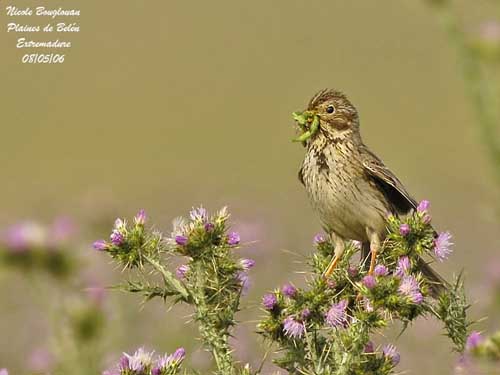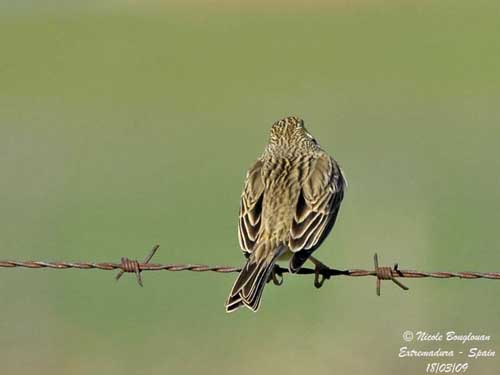
Corn Bunting
Emberiza calandra
Passeriforme Order – Emberizidae Family
BIOMETRICS:
Length: 17-19 cm
Weight: 32-67 g
DESCRIPTION:
The Corn Bunting is often seen perched on exposed wires, fences, branches or posts. This bird is heavily built and resembles a Skylark. It is larger than other buntings.
Male and female have similar plumage but the male is larger.
The adult has grey-brown upperparts with darker streaks. Rump and uppertail-coverts show more diffuse and greyer markings, and are slightly paler. On the upperwing, the dark brown feathers are edged and tipped buffy or pale grey. The tail is brown, with indistinct whitish tips to the outermost rectrices.
Fr: Bruant proyer
All : Grauammer
Esp : Escribano Triguero
Ital : Strillozzo
Nd: Grauwe Gors
Sd: Kornsparv
Port : Trigueirão
Texte et photos de Nicole Bouglouan
Sources :
HANDBOOK OF THE BIRDS OF THE WORLD Vol 16 by Josep del Hoyo- Andrew Elliot-David Christie – Lynx Edicions – ISBN: 9788496553781
ENCYCLOPEDIE DES OISEAUX DE FRANCE ET D’EUROPE – de Peter Hayman et Rob Hume - Flammarion – ISBN : 2082009920
THE COMPLETE BOOK OF BRITISH BIRDS – Written by “Royal Society for the Protection of Birds” experts - Préface de Magnus Magnusson - Michael Cady- Rob Hume Editors - ISBN: 0749509112
BirdLife International (BirdLife International)
Pájaros de España (JL Beamonte)
Wikipedia, the free encyclopaedia

On the underparts, chin and throat are whitish. Rest of underparts are whitish to pale buff with conspicuous dusky streaks on breast, flanks and body sides, and sometimes undertail-coverts. According to each bird, the blackish streaks may form a dark patch at centre of breast.
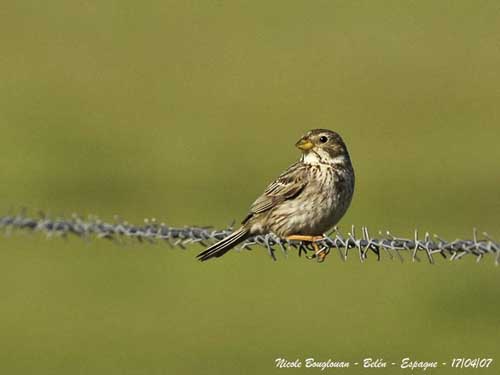
On the head, crown, nape and ear-coverts are grey-brown or olive-brown, with narrow darker streaks. Ear-coverts can be slightly darker brown. Lores and supercilium are paler. A dark malar stripe borders the whitish chin and breast, and the whitish submoustachial stripe shows fine darker streaks.
The stout bill is pale yellow with grey culmen ridge. The mandibles have S-shaped cutting edges. The eyes are dark brown. Legs and feet are pale pinkish-brown.
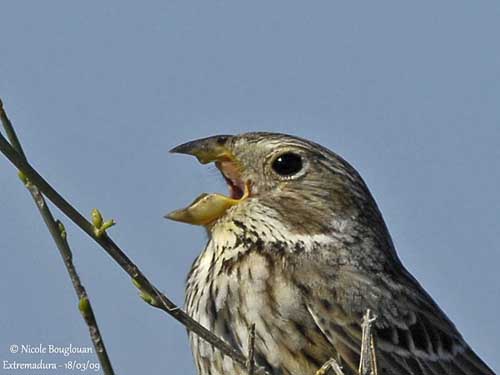
The juvenile is paler above with darker and broader streaks. The underparts are less streaked than in adults.
We can find three subspecies, E.c. clanceyi, E.c. calandra and E.c. buturlini. They differ in plumage tone and streaking.
VOICE: SOUNDS BY XENO-CANTO
The Corn Bunting’s usual call is a distinctive “pit”, often rapidly repeated 5-6 times. We can also hear a “quip”.
The metallic song of the male resembles the sound produced by a bunch of keys. There are 2-3 notes followed by rapid, discordant “tik tik zreeississ” which may vary in length.
This bird often sings from exposed perches, sometimes during one hour.
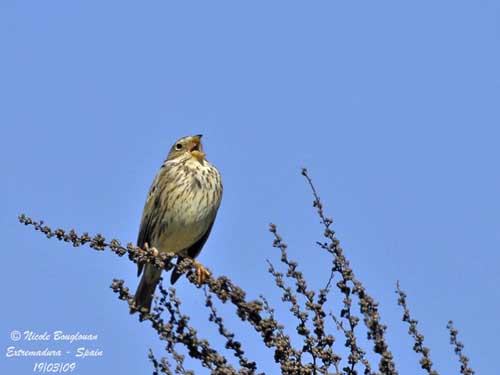
HABITAT:
The Corn Bunting frequents open areas such as grasslands in steppes or cultivated areas. It usually avoids important bushy covert, but it can be seen in open places with scattered bushes.
Outside the breeding season, it frequents fallow fields and stubble fields. They often roost in reedbeds (Phragmites).
This species occurs mainly in lowlands, but it may reach 2600 metres of elevation in some parts of C Asia.
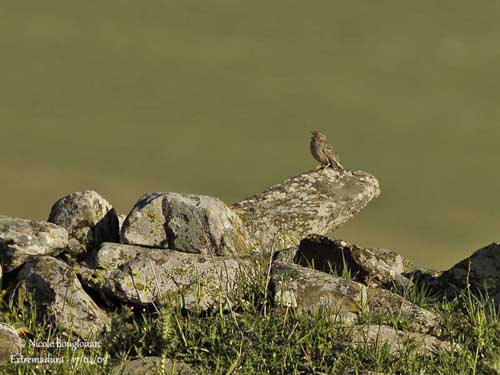
RANGE:
The Corn Bunting is mainly resident and breeds in S and C Europe, N Africa, Asia to Kazakhstan. However, the populations of the cold regions of C Europe and Asia often move southwards during winter.
BEHAVIOUR:
The Corn Bunting feeds mainly on plant matter such as seeds, leaves, grass, roots and fruits from numerous plant species… During the breeding season, there is a great variety of invertebrates such as small insects and spiders, butterflies, caterpillars, and also snails, slugs and earthworms.
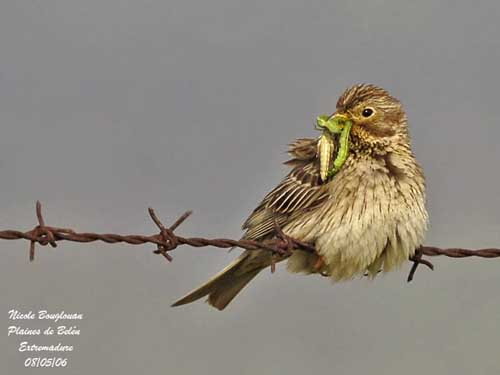
This species feeds usually on the ground by short hops. It may sometimes perform weak flycatching at insect emergence.
We can see large flocks of several hundreds outside the breeding season. This species is gregarious, but tends to avoid close proximity of other buntings.
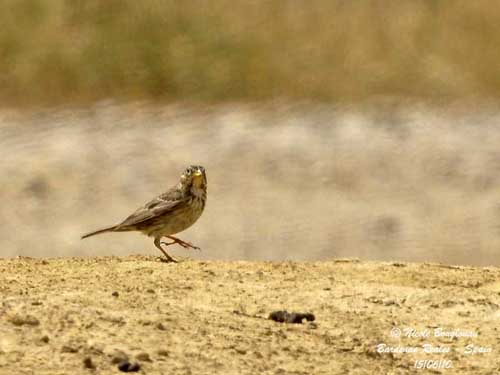
At the beginning of the breeding season, the territory is established and includes several perches such as wires, poles, trees, used by the male for singing. It also performs flight displays, short vertical flights with soaring at low height with dangling legs, and circling above the female. Sometimes, the male’s wings are quivering during the flight.
Several males are polygamous with 2-4 females within their territory, sometimes much more, with their nests relatively close to each other, usually a few metres.
The male often pursues rivals by low flight over the cornfields.
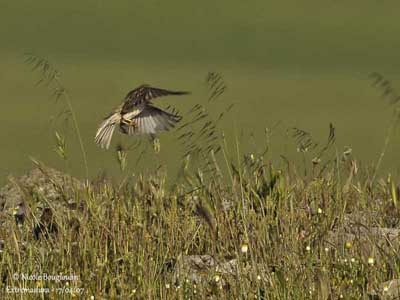

FLIGHT:
The Corn Bunting performs fluttering flight with dangling legs between its favourite perches.
REPRODUCTION:
The laying occurs fairly late, from late May to early June in NW of the range, and earlier in the southern parts. This species produces one or two broods per season, sometimes three.
The female builds the nest on the ground. This is a loose structure made with grasses. The interior is lined with finer materials, grasses and rootlets. It is placed in a clump of grasses, brambles and weeds, but sometimes in a depression in cultivated fields.
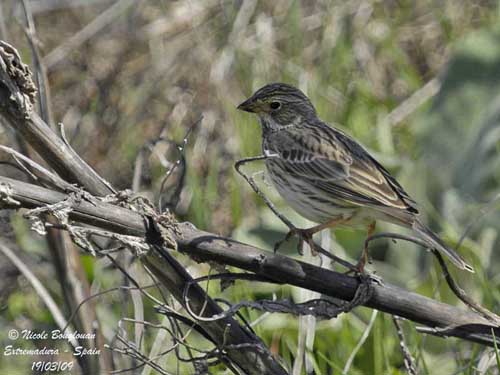
The female lays 4-6 white eggs washed pale blue to buffish with some dark markings. The female incubates alone during 12-14 days. The chicks are fed by the female while the male sings continuously. It may come to the nest, but it does not take part in feeding chicks. The female feeds them with green caterpillars found in the surroundings. When she leaves the nest, the male also leaves its perch and follows her. Then, it sings again from its perch while the female feeds the young.
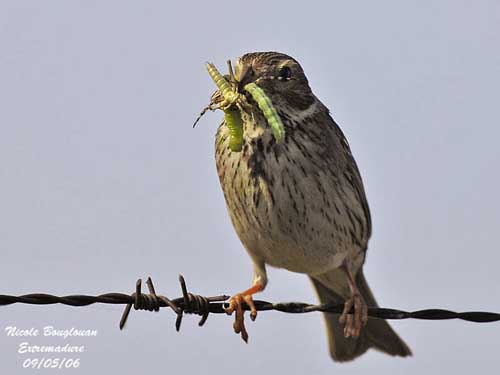
They fledge about 9-13 days after hatching, but they are not able to fly when they leave the nest. They remain hidden in the thick grasses around the nest.
DIET:
The Corn Bunting feeds mainly on plant seeds, from weeds and grasses, cereals, and the winged sycamore seeds of Acer.
During the nesting period, they catch mainly invertebrates such as insects and spiders, caterpillars, snails, slugs and earthworms.
They forage on the ground by short hops.
PROTECTION / THREATS / STATUS:
The Corn Bunting is widespread and abundant in most parts of the range.
However, some decline through the last century has been observed, due to intensification of agriculture, changes in the habitat, loss of vegetation and climate change.
But this species is not currently threatened.
